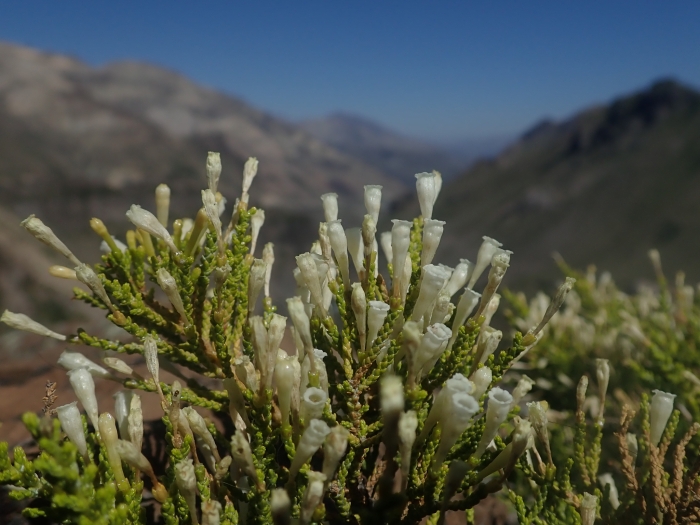Pichi
(Fabiana imbricata)
Pichi (Fabiana imbricata)
/
/

Nolan Exe
CC BY 4.0
Image By:
Nolan Exe
Recorded By:
Copyright:
CC BY 4.0
Copyright Notice:
Photo by: Nolan Exe | License Type: CC BY 4.0 | License URL: http://creativecommons.org/licenses/by/4.0/ | Rights Holder: Nolan Exe | Publisher: iNaturalist | Date Created: 2019-12-07T05:35:02-08:00 |












Estimated Native Range
Summary
Fabiana imbricata, commonly known as Pichi, is an evergreen shrub native to the arid and semi-arid regions of the Andes in Southern South America. It typically grows to 2.5 m (8 ft 2 in) tall and wide, resembling a heath in form. Pichi thrives in rocky soils and is adapted to survive with minimal water, making it suitable for xeriscaping. Its needle-like leaves are an adaptation to its dry native habitat, reducing water loss, and it produces small, white, tubular flowers in early summer that are modest in showiness.
Pichi is valued for its drought tolerance and evergreen foliage, which provides year-round interest in the garden. It is often used in rock gardens, as a low-maintenance ornamental shrub, or for erosion control on slopes. The plant’s ability to thrive in full sun with low water requirements makes it an excellent choice for water-wise landscaping. The cultivar F. imbricata f. violacea is notable for its pale violet flowers and has received the Royal Horticultural Society’s Award of Garden Merit. While Pichi is generally disease-resistant, it can be susceptible to root rot in poorly drained soils. It is also important to note that Pichi may not tolerate extremely cold temperatures, so it is best suited to regions with mild winters.CC BY-SA 4.0
Pichi is valued for its drought tolerance and evergreen foliage, which provides year-round interest in the garden. It is often used in rock gardens, as a low-maintenance ornamental shrub, or for erosion control on slopes. The plant’s ability to thrive in full sun with low water requirements makes it an excellent choice for water-wise landscaping. The cultivar F. imbricata f. violacea is notable for its pale violet flowers and has received the Royal Horticultural Society’s Award of Garden Merit. While Pichi is generally disease-resistant, it can be susceptible to root rot in poorly drained soils. It is also important to note that Pichi may not tolerate extremely cold temperatures, so it is best suited to regions with mild winters.CC BY-SA 4.0
Plant Description
- Plant Type: Shrub
- Height: 6-8 feet
- Width: 4.5-6 feet
- Growth Rate: Moderate
- Flower Color: Purple
- Flowering Season: Spring, Summer
- Leaf Retention: Evergreen
Growth Requirements
- Sun: Full Sun
- Water: Low
- Drainage: Slow
Common Uses
Bank Stabilization, Bee Garden, Bird Garden, Border Plant, Deer Resistant, Drought Tolerant, Hummingbird Garden, Low Maintenance, Potted Plant, Rock Garden, Salt Tolerant, Showy Flowers
Natural Habitat
Arid and semi-arid regions of the Andes in Southern South America
Other Names
Common Names: Pichi-Romero, Pichi Pichi, Fabiana
Scientific Names: , Fabiana imbricata, Fabiana imbricata var. biflora, Fabiana biflora, Fabiana araucana, Fabiana lutescens,
GBIF Accepted Name: Fabiana imbricata Ruiz & Pav.